Jawbreaker
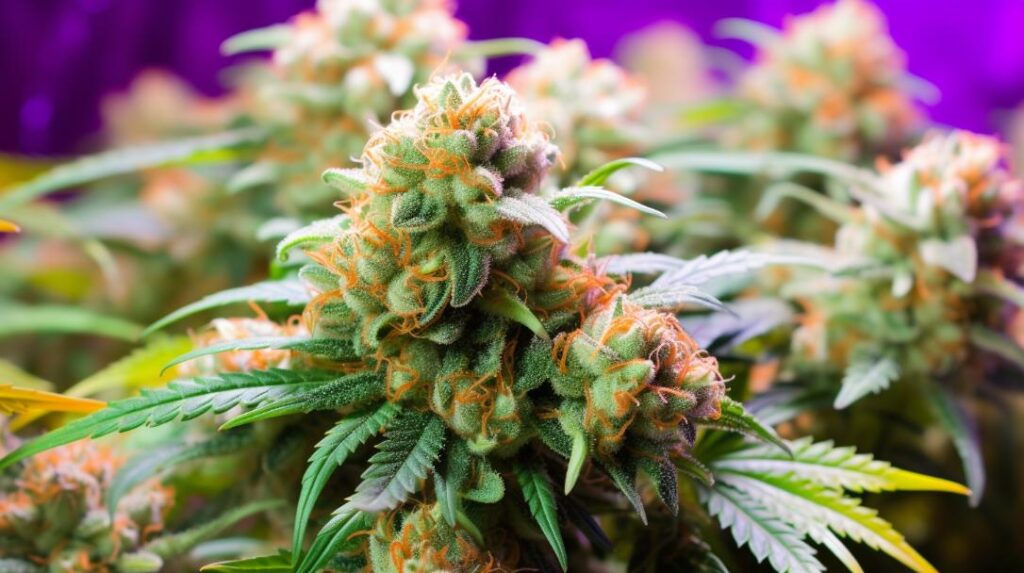
The Jawbreaker strain, derived from Purple Punch and Grape Pie, exhibits a synergistic combination of sedative effects and intricate flavors. Characterized by its THC content of 20%-25%, it provides a substantial cerebral experience, underpinned by a lower CBD concentration. Its terpene profile, consisting principally of myrcene, caryophyllene, and limonene, contributes not only to its distinctive aroma and flavor but also to its therapeutic potential. Clinically, it has been found effective against depression, fatigue, and stress, while its high THC levels promote happiness, relaxation, and sociability. Significantly, its unique flavor and aroma enhance user experience, indicating a direct correlation with its terpenes. Unfolding its characteristics further reveals a deeper understanding of its extensive benefits.
Genetic Lineage
The Jawbreaker strain boasts a distinguished genetic lineage, being a hybrid culmination of Purple Punch and Grape Pie, known for its sweet, fruity flavor profile and potent effects. This sophisticated genetic combination yields a strain that is not just remarkable for its aroma and taste but also for its multifaceted medical applications. The ancestry of Jawbreaker, with Purple Punch contributing its sedative properties and Grape Pie adding a nuanced, complex flavor, creates a synergistic effect that is particularly beneficial in the medical cannabis community.
Jawbreaker’s therapeutic potential is vast, with its effects being especially relevant in treating conditions such as depression, pain, and nausea. The strain’s capacity to induce happiness and relaxation is critical for patients suffering from mental health issues, providing a much-needed uplift in mood and general well-being. Its analgesic properties make it a valuable option for pain management, offering relief without the significant side effects associated with conventional medications. The anti-emetic qualities of Jawbreaker, beneficial for those experiencing nausea, underline its importance in thorough patient care, particularly for individuals undergoing treatments like chemotherapy that often result in such side effects.
THC/CBD Content
Analyzing the Jawbreaker strain reveals a THC concentration ranging from 20% to 25%, juxtaposed with a comparatively lower CBD content, underscoring the strain’s potent psychoactive potential. This substantial THC level positions Jawbreaker among the more potent cannabis varieties, indicative of its ability to produce profound euphoric and psychoactive effects. The relatively minimal CBD content, while not negligible, plays a less prominent role in the strain’s overall profile, suggesting that the psychoactive effects may not be notably tempered by CBD’s modulating properties.
The disparity in cannabinoid content—specifically the dominance of THC over CBD—highlights the strain’s design towards delivering a robust, cerebral experience. For consumers seeking a potent impact with less emphasis on CBD-related benefits such as anti-inflammatory or anxiolytic effects, Jawbreaker presents an appealing option. The balance of cannabinoids within this strain, despite the low CBD level, may still contribute to a well-rounded user experience due to the entourage effect, where the presence of multiple cannabinoids and terpenes can enhance the overall efficacy and experience.
Understanding the THC/CBD content in Jawbreaker strain is essential for users aiming to tailor their cannabis consumption to achieve desired effects, whether for recreational enjoyment or therapeutic purposes.
Terpene Profile
Exploring the terpene profile of the Jawbreaker strain uncovers a complex synergy among myrcene, caryophyllene, and limonene, each contributing unique effects and aromas to this potent cannabis variety. The interplay of these terpenes not only defines the distinctive olfactory and gustatory experience associated with Jawbreaker but also hints at its potential therapeutic applications. Myrcene, recognized for its sedative properties and presence in mangoes, suggests a relaxing effect. Caryophyllene, with its spicy undertone, brings potential anti-inflammatory benefits to the mix. Meanwhile, limonene, known for its uplifting citrus scent, may enhance mood. This terpene trio enriches the cannabis experience by offering a nuanced profile that appeals to both connoisseurs and medicinal users alike.
| Terpene | Contribution |
|---|---|
| Myrcene | Relaxation, Mango-like Aroma |
| Caryophyllene | Spiciness, Anti-inflammatory Properties |
| Limonene | Citrusy Aroma, Mood-enhancement |
| Understanding | Predicts Effects and Flavors |
| Synergy | Complex Aroma and Therapeutic Potential |
This detailed analysis underscores the importance of terpenes in shaping the characteristics and perceived benefits of the Jawbreaker strain, highlighting the scientific curiosity surrounding the cannabis sector’s ongoing exploration of plant chemistry.
Effects
Jawbreaker strain effects, characterized by happiness, relaxation, and increased sociability, offer a multifaceted response in users that extends beyond mere recreational enjoyment to potential therapeutic applications. The strain’s capacity to induce feelings of focus and hunger highlights its complex interaction with the body’s endocannabinoid system, suggesting a nuanced modulation of neural pathways involved in mood regulation and appetite control. This particular profile of effects, combining psychoactive properties with physiological responses, presents a valuable case study in the broader context of cannabis research, particularly in the domains of psychological well-being and health.
However, the presence of dizziness as a reported negative side effect underscores the importance of dosage management and individual sensitivity considerations in the consumption of Jawbreaker strain. The flavors associated with this strain, including berry, grape, and tree fruit, may play a role in its appeal and perceived effects, potentially influencing user experience through olfactory and gustatory pathways.
Medical Uses
The therapeutic potential of the Jawbreaker strain, particularly in addressing conditions such as depression, fatigue, and stress, has been highlighted by user reports, pointing towards its significant role in the domain of medical cannabis. Its efficacy can be attributed to the strain’s high THC content, ranging between 20%-25%, which facilitates a state of happiness, relaxation, and talkativeness. These effects not only cater to recreational needs but also possess substantial medical value for professionals exploring strains with similar effects.
| Condition | Effect | Professional Insight |
|---|---|---|
| Depression | Happiness | May counteract depressive episodes |
| Fatigue | Focus & Talkativeness | Enhances mental clarity and energy levels |
| Stress | Relaxation | Induces a calming effect on the user |
| Side Effects | Dizziness | To be monitored and managed |
In an analytical view, the Jawbreaker strain demonstrates a broad spectrum of potential therapeutic uses. However, it’s essential to note the reported side effect of dizziness, which requires professional management to ensure safety and efficacy. The user-reported feelings of happiness, focus, and hunger further support the strain’s use in medical scenarios, aligning with the needs of individuals suffering from the aforementioned conditions.
Flavor and Aroma
Oftentimes, the sensory experience of a cannabis strain, such as its flavor and aroma, plays a pivotal role in its overall appeal and therapeutic efficacy. The Jawbreaker strain exemplifies this principle through its distinctive sweet and fruity profile that is both alluring and beneficial for users seeking specific therapeutic outcomes. Analytically, the strain’s flavor composition is rich with notes of berry, grape, and tree fruit, creating a complex palate that mirrors the intricate chemical makeup of the plant. This candy-like aroma not only enhances the user experience by invoking a sense of nostalgia and pleasure but also indicates the presence of specific terpenes that may contribute to the strain’s purported therapeutic effects.
Technical analysis of the Jawbreaker strain’s flavor and aroma reveals a correlation between its sweet and fruity characteristics and its reported effects on happiness, focus, and appetite stimulation. While the sensory attributes are enjoyable in their own right, they also serve as markers for the strain’s efficacy in addressing conditions such as depression, fatigue, and stress. However, users should be cognizant of potential negative effects such as dizziness, which underscores the importance of moderation and individual sensitivity to the strain’s potent sensory profile.
Appearance
Visual examination of the Jawbreaker strain reveals buds that are both dense and compact, characterized by an eye-catching interplay of greens and purples, accented with bright orange pistils. This strain’s visual appeal is heightened by the presence of trichomes, which cover the buds in a frosty layer, indicative of its potent nature. People say it helps not only with various conditions but also provides an aesthetically pleasing experience, contributing to its overall desirability.
The buds of the Jawbreaker strain are typically medium to large in size, presenting a visually appealing structure that is robust and well-formed. The leaves of this strain can exhibit deep purple hues, further enhancing the visual complexity and allure of the plant. Such characteristics are not merely superficial but are often associated with the strain’s potency and efficacy, as reported by users.
Moreover, when properly cultivated, Jawbreaker buds possess a sticky texture and a slight resinous sheen, which are tell-tale signs of a high-quality cannabis strain. This tactile aspect complements its visual attributes, making Jawbreaker a strain that is as appealing to the touch as it is to the eye. Overall, the appearance of Jawbreaker is a confirmation of its careful cultivation, with people saying it helps underscore the importance of aesthetic considerations in the cultivation and selection of cannabis strains.
Grow Information
Cultivating the Jawbreaker strain, a hybrid offspring of Purple Punch and Grape Pie, requires specific environmental conditions and careful attention to detail to maximize its potential THC content ranging from 20% to 25%. This strain’s ideal growth demands a controlled environment where temperature, humidity, and lighting are meticulously managed. Given its sweet and fruity flavor profile with a candy-like aroma, ensuring the right conditions is essential for developing the terpene profile that makes Jawbreaker so unique.
To achieve peak growth, cultivators should consider the following:
-
Lighting: Jawbreaker thrives under a regime of high-intensity light. Utilizing LED or HPS lamps can guarantee adequate light penetration, essential for the development of dense, resinous buds.
-
Nutrition: This strain demands a rich, well-sourced nutrient regimen tailored to its specific stage of growth. Over or under-fertilization can have a notable impact on both yield and potency.
-
Climate Control: Maintaining a consistent temperature and humidity level within the growing area is crucial. Sudden changes can stress the plant, leading to suboptimal growth and potentially lower THC levels.
Successful cultivation of Jawbreaker requires not just an understanding of these factors but also the ability to adjust and respond to the plant’s needs throughout its growth cycle. Given its potential benefits for conditions like depression, pain, and nausea, the effort put into cultivating this strain can be highly rewarding.
Adverse Effects
While the Jawbreaker strain is celebrated for its therapeutic benefits, it is important to note that some users may experience dizziness as a significant adverse effect. This phenomenon is not isolated but has been reported sufficiently to warrant attention from both users and researchers alike. Dizziness, as a symptom, encompasses a range of sensations including a feeling of unsteadiness, lightheadedness, or the sensation of the environment spinning around the individual, known medically as vertigo.
The occurrence of dizziness after consuming the Jawbreaker strain suggests an interaction within the body’s endocannabinoid system that may affect balance and spatial orientation. It is imperative for users to monitor their individual reactions to this strain, especially if they are new to its use or have a history of sensitivity to cannabis-induced dizziness. Recognizing the onset of dizziness can help users manage their intake and avoid potential discomfort or hazardous situations, especially those involving coordination or operation of machinery.
Comparisons with Similar Strains
When contrasting the Jawbreaker strain with other hybrids like Tyson 2.0, it is important to take into account their genetic backgrounds, THC content, flavor profiles, and the effects they bring about for the user. These factors not only influence the user’s experience but also guide professionals before using cannabis for therapeutic purposes.
-
Genetic Background: Jawbreaker originates from a blend of Purple Punch and Grape Pie, offering a unique combination that leans towards sweet and fruity flavors. Tyson 2.0, on the other hand, is a hybrid of Gelato #41 and Triangle Kush, known for its woody, floral, and earthy tones. This genetic makeup directly influences the sensory experience and potential therapeutic uses of each strain.
-
THC Content: With a THC range of 20%-25%, Jawbreaker presents a moderately potent option for users seeking balance. Tyson 2.0 boasts a higher THC level at 29.68%, positioning it as a stronger choice for those with higher tolerance or specific therapeutic needs.
-
Effects: Jawbreaker is associated with happiness, relaxation, and talkativeness, making it suitable for social situations or combating stress. Tyson 2.0’s effects, including appetite stimulation, relaxation, and sleepiness, cater to users needing aid with appetite issues or insomnia.
Understanding these comparisons is essential for making informed decisions, especially for professional recommendations before using cannabis for health and wellness purposes.
Research and Studies
Understanding the comparisons between Jawbreaker and similar strains sets the stage for a deeper exploration into the specific research and studies conducted on the Jawbreaker strain itself. This particular strain emerges from a hybridization of Gelato #41 and Triangle Kush, exhibiting a rich woody, floral, and earthy flavor profile. The technical analysis and research surrounding Jawbreaker underscore its significant THC content, recorded at 29.68%. Such a high THC level is indicative of its potent effects, especially appetite stimulation, relaxation, and sleepiness. These outcomes are critical for both medical and recreational users, guiding them in strain selection based on desired effects.
Available at the Tyson 2.0 dispensaries in San Diego, CA, Jawbreaker is part of a curated selection of strains. The dispensary, known for its robust research-backed offerings, provides a valuable resource for consumers seeking strains with specific THC levels and effects. Moreover, the Mission Valley store extends the research footprint by offering strains like Corkscrew, Oakstradam OG, and Skywalker, alongside fresh drops including Red Cherry Gelato and SFV OG. This diversity underscores the importance of ongoing research and the role of dispensaries in disseminating findings, ensuring consumers are well-informed about their choices within the San Diego cannabis landscape.
History and Origin
The Jawbreaker strain, a unique hybrid resulting from the crossbreeding of Purple Punch and Grape Pie, has its roots deeply embedded in the evolving landscape of cannabis genetics. This strain is a tribute to the skillful art of modern breeding, aiming to combine the best characteristics of its parent strains. Purple Punch, known for its potent effects and sweet flavor profile, plays an essential role in the heritage of Jawbreaker.
Here are three key points about the history and origin of the Jawbreaker strain:
-
Genetic Lineage: The strain owes its existence to the meticulous selection of Purple Punch and Grape Pie, chosen for their complementary traits. Purple Punch contributes to the sweet and fruity flavor profile, while Grape Pie adds a candy-like aroma, making Jawbreaker a desirable choice for enthusiasts seeking a flavorful experience.
-
THC Content: With a THC range of 20% to 25%, the Jawbreaker strain stands out for its potency. This is a reflection of its Purple Punch heritage, which is known for producing strong and relaxing effects.
-
Therapeutic Use: The strain is not just appreciated for recreational purposes; it’s also sought after for its potential therapeutic benefits, including alleviating symptoms of depression, pain, and nausea. This aspect further underscores the importance of its genetic roots, particularly Purple Punch, in shaping its profile.
Frequently Asked Questions
What Strain Is Jawbreaker?
Jawbreaker is a hybrid cannabis strain with genetic origins in Purple Punch and Grape Pie. It is characterized by a THC content of 20% to 25%, offering a sweet, fruity flavor profile and various therapeutic benefits.
What Strain Gets You High the Longest?
In evaluating the durability variations among cannabis strains, it’s evident that those with high THC levels tend to offer a more prolonged high. Factors such as genetic makeup and hybridization play essential roles in this dynamic.
What Is the Strongest Indica Strain Ever?
The strongest Indica strain ever, ‘Godfather OG,’ epitomizes genetic evolution with THC levels up to 34%. Its lineage combines Granddaddy Purple, Cherry Pie, and OG Kush, showcasing a technical, detailed, and analytically robust genetic profile.
What Strain Has the Strongest Body High?
In relation to the question about the strain with the most powerful body high, it is crucial to take into account cannabinoid levels. High THC concentrations are pivotal in providing potent body effects, triggering deep relaxation and significant physical sedation.


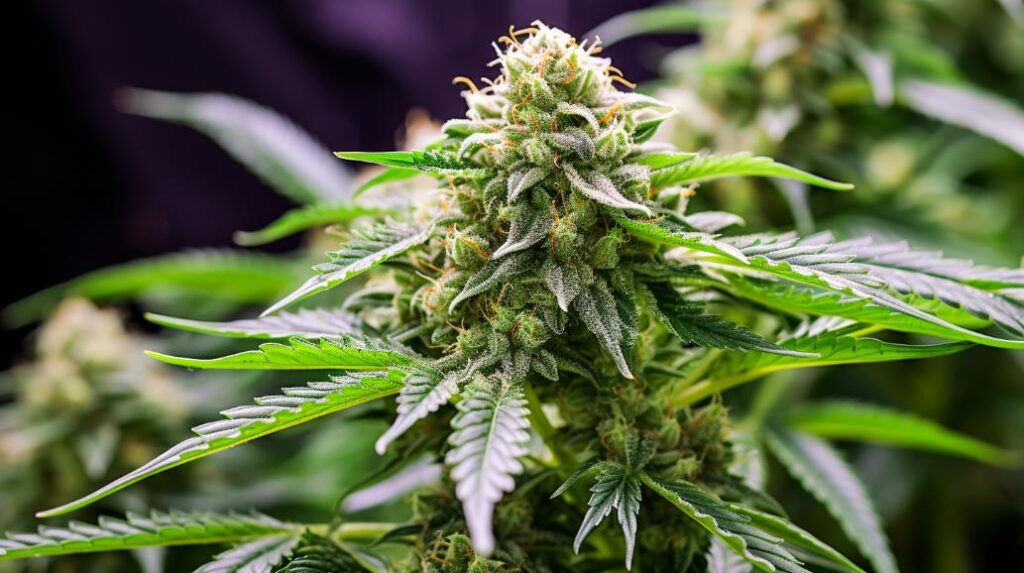
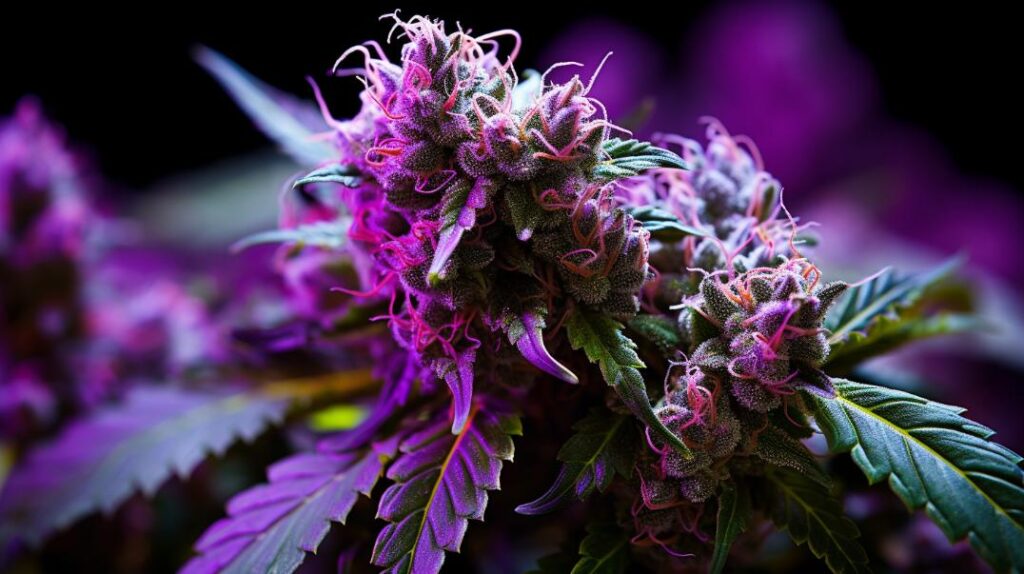
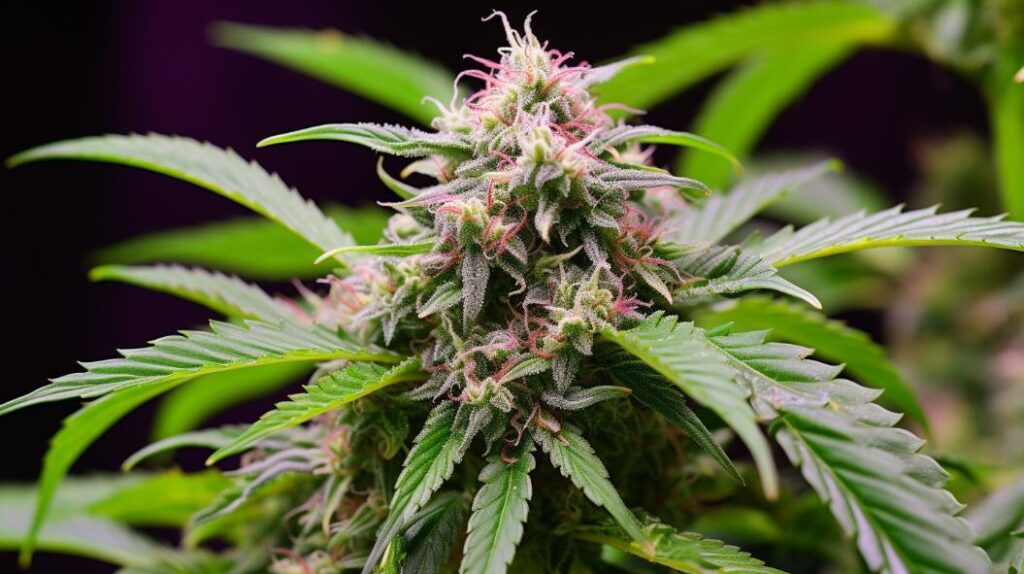
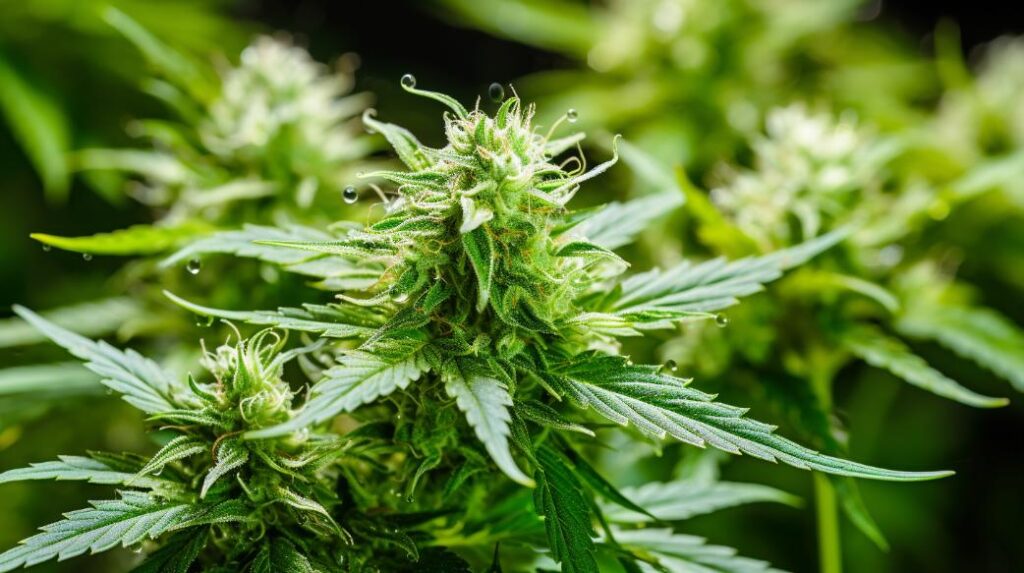

Responses